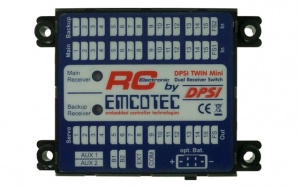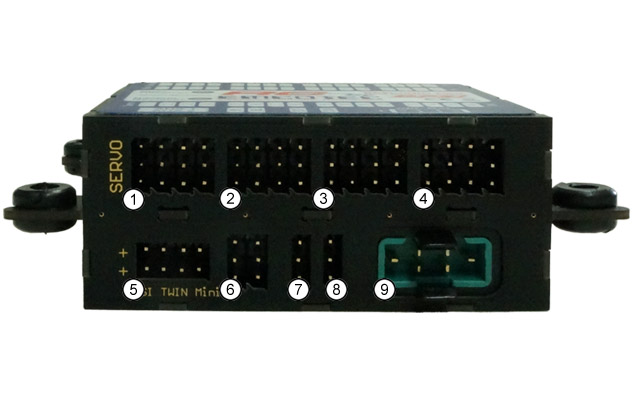DPSI TWIN Mini
Contents
- 1 Product description
- 2 Features
- 3 Delivery contents
- 4 Mounting suggestions
- 5 Functions and modes
- 6 Function principle of switchover
- 7 The failsafe channels FS1 and FS2
- 8 Connection description
- 9 Connection of the receivers
- 10 Connection of the servos and voltage supply
- 11 Switching on and off
- 12 Status and error indication
- 13 Programming
- 14 Technische Daten
- 15 Abmessungen
- 16 Downloads
Product description
The DPSI TWIN Mini 2015 provides receiver diversity with two receivers. So a higher reliability is achieved. Furthermore the DPSI TWIN Mini can be used as a teacher/student system.
Features
| Feature | implemented |
|---|---|
| Electronic switch | No |
| Dual power supply | No |
| Voltage regulator | No |
| Servo current distribution | No |
| Servo signal distribution | No |
| Receiver switch | Yes |
Delivery contents
- 1 DPSI TWIN Mini
- 20 Receiver patch cables
- 1 Quick reference guide
Mounting suggestions
Take care of vibration-free fixing when mounting the DPSI TWIN Mini. So the DPSI TWIN Mini e. g. could be mounted vibration-cushioned on four silicone hose pieces.
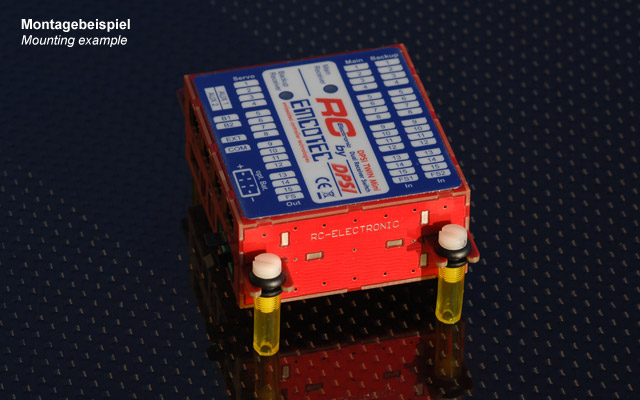
|
Functions and modes
The DPSI TWIN Mini supports to different modes.
Safety Mode
In Safety Mode all servos will be switched to the backup receiver in case of failure of the main receiver. The switching happens automatically in case of failure so an error message will be displayed on the DPSI TWIN Mini's LED. In Safety Mode the transmitter must be bound to both receivers. The Safety Mode is programmed in default. If the DPSI TWIN Mini should be operated in Safety Mode no further programming before first usage is necessary.
Teaching Mode
The Teaching Mode is a teacher/student function which allows toggling between main and backup receiver by the teacher. The teacher can enable all functions on the student's transmitter and get them back to his own transmitter in case of emergency. The switching between main and backup receiver is made with intention by the teacher so no error message will be displayed on the DPSI TWIN Mini's LED. In Teaching Mode each receiver is bound to its own transmitter.
Info: Providing of single functions to the student is not possible.
The Teaching Mode must be activated before first usage. Find details in chapter Programming.
Data logger
The DPSI TWIN Mini‘s data logger records all operating relevant information of the last flight and saves them. This information can be displayed with a PC and the software xxxxxxxxxxxx. Then with this information (failsafe signals, amount and duration of receiver failures) e. g. the reason for a crash can be determined.
Function principle of switchover
Inside the DPSI TWIN Mini the switchover function between two receivers is based on the two failsafe channels FS1 und FS2. The PWM signals of the receivers connected to the failsafe channels are analysed by the DPSI TWIN Mini. As long as the signal has a value higher than +75% (percentage of the servo channel) the recent receiver connected at the receiver inputs Main is used. This receiver distributes the signals to the servos.
When the signal decreases und -75% the DPSI TWIN Mini recognizes a failsafe status and all 16 servo signals are switched to the backup receiver connected on the receiver inputs Backup. If the failsafe pulses are missing or out of specification this is also considered as a error and toggling will take place.
The failsafe status occurs e. g. when the receiver has a malfunction. When used Safety Mode switchover is made automatically. The failsafe status can be induced intentionally by sending an appropriate signal over the failsafe output. This is applied when using Teaching mode. Find details concerning the modes in chapter Funktionen und Modi.
The 75% values are programmed in standard and can be changed if desired. Find details in chapter Programming.
The failsafe channels FS1 and FS2
Failsafe ready channels of the two receivers must be connected to the failsafe channels FS1 and FS2. The failsafe signals of the connected receivers will be analysed for the switching over between the two receivers by the DPSI TWIN Mini.
The failsafe channels itself will also be switched to the faultless receiver in case of switchover. So they can be used as receiver channels only with limitation.
Within DPSI TWIN Mini's factory settings a receiver is recognized as faultless when failsafe signal is longer than 1.8ms (+75% servo...). The receiver signal is faulty when failsafe signal is shorter than 1.2ms (-75% servo...).
A receiver switchover takes place when failsafe signal is shorter than 1.2ms (-75% servo...). So the transmitter's failsafe position must be smaller than -75% (e. g. -80% or -100%).
Hint: The range from -75& to +150% is free for use on the failsafe channels because no switchover will be triggered there. When failsafe channels are in use the servo can be operated only inside range -75% to +150%. When reaching the failsafe thresold the servo must not run mechanically.
Connection description
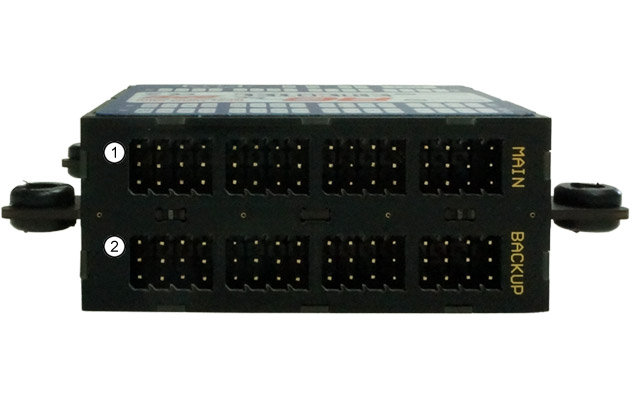
DPSI TWIN Mini connections back side: 1. Connections Main for main receiver's patch cables | 2. Connections Backup backup receiver's patch cables |
Connection of the receivers
The both receivers can be connected on the DPSI TWIN Mini‘s back side. The main receiver‘s channels must be feeded through the receiver inputs Main, the backup receiver's channels must be feeded through the receiver inputs Backup. Up to 16 channels can be feeded through.
The failsafe channels FS1 and FS2 are also available for a function as channel 16. Find details concerning the failsafe channels FS1 and FS2 in chapter The failsafe channels FS1 and FS2.
Hinweise
- The receiver channels of both receivers must be allocated identically
- Not all 16 channels of the DPSI TWIN Mini must be used
- Both failsafe inputs of the DPSI TWIN Mini must be used because the error identification of the receivers happens there.
Connection of the servos and voltage supply
There are three options for voltage supply and operating servos on the DPSI TWIN Mini.
Operating with a DPSI battery backer without servo current distribution
When used with a DPSI battery backer without servo current distribution the servos will be connected directly to the DPSI TWIN Mini's servo outputs Servo. The DPSI TWIN Mini and the connected receivers are supplied with voltage eighter from the inputs B1 and B2 or from the input opt. Bat where the DPSI battery backer is connected.
The following DPSI battery backers without current distribution can be used with the DPSI TWIN Mini:
- DPSI Micro DualBat series
- DPSI BIC
- DPSI Ampere optional with or without voltage regulator DPSI Voltage
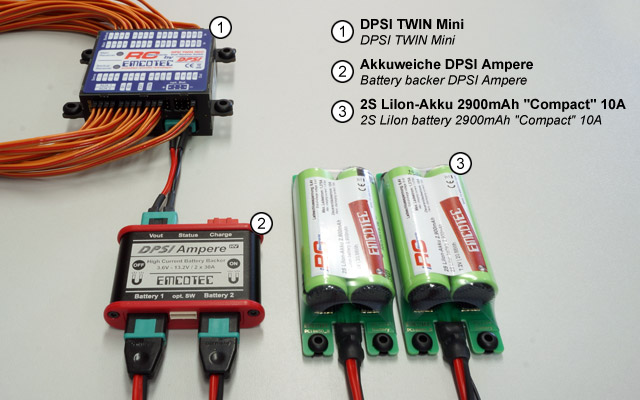
DPSI TWIN Mini mit Akkuweiche DPSI Ampere: 1. DPSI TWIN Mini | 2. Battery backer DPSI Ampere | 3. 2S LiIon battery 2900mAh "Compact" 10A |
Operating with a DPSI battery backer with servo current distribution
When used with a DPSI battery backer with servo current distribution the servos will not be connected directly to the DPSI TWIN Mini's servo outputs Servo. In that case the DSPI TWIN Mini's servo outputs Servo will be connected with patch cables to the receiver inputs of the DPSI battery backer. The DPSI TWIN Mini and the connected receivers are supplied with voltage from the patch cables that are connected with the DPSI battery backer.
The following DPSI battery backers with current distribution can be used with the DPSI TWIN Mini:
- DPSI 2001 RV Version 2014
- DPSI RV (2010)
- DPSI RV Mini series
Operating without battery backer
When used without a DPSI batter backer the servos will be connected directly to the DPSI TWIN Mini's servo outputs Servo. The DPSI TWIN Mini and the connected receivers are supplied with voltage from the opt. Bat where an external battery is connected.
Switching on and off
The DPSI TWIN Mini has no integrated switch. It will be switched on by connecting the current supply. When operated with a DPSI battery backer the DPSI TWIN Mini will be switched on when the battery backer will be switched on with the magnetic switch or the external switch actuator. When operated without DPSI battery backer the DPSI TWIN Mini will be switched on when an axternal battery is connected to the input opt. Bat. See more information concerning voltage supply in chapter Connection of the servos and voltage supply. After switching on the DPSI TWIN Mini passes the following periods (5 seconds duration):
- Increasing the data logger entry and increasing of switching on counter
- Scanning COM port and checking if PC communication must be established (diagnosis mode or firmware update)
When self test was successful the DPSI TWIN Mini changes in normal mode after 5 seconds. The integrated LEDs will show the recent status, the Main LED is green. From now on the COM port is inactive.
Status and error indication
The DPSI TWIN Mini shows receiver status as well as errors on two LEDs. One LED shows status and errors of the main receiver the other LED shows status and errors of backup receiver. In case of errors the error indication will be repeated all 12 seconds. The recent active receiver will be shown by the permanent illuminated LED on the DPSI TWIN Mini's top side. If an LED is flashing for e. g. three times the corresponding receiver had three errors.
Die integrierten LEDs zeigen den aktuellen Status sowie Fehler der Empfänger wie folgt an:
| Systemzustand | LED Main Receiver | LED Backup Receiver |
|---|---|---|
| Hauptempfänger ist aktiv | Grün | --- |
| Backupempfänger ist aktiv | --- | Grün |
| Fehler im Hauptempfänger | Rote LED blinkt 1x = 1 Fehler 2x = 2 Fehler 9x = 9 Fehler Dauer = mehr als 9 Fehler |
Grün |
| Fehler im Backupempfänger | Grün | Rote LED blinkt 1x = 1 Fehler 2x = 2 Fehler 9x = 9 Fehler Dauer = mehr als 9 Fehler |
| PC-Kommunikation | Rot | Rot |
| Firmware-Update | Schnelles Wechselblinken rot/grün | Schnelles Wechselblinken rot/grün |
Wenn die LED für den Haupt- bzw. Backupempfänger beispielswiese 5x blinkt bedeutet dies, dass auf dem entsprechenden Empfänger fünf Fehler aufgetreten sind.
Programming
Bei Auslieferung ist die DPSI TWIN Mini im Safety-Modus programmiert. Der Teaching-Modus sowie die Pass-/Fail-Werte können der PC-Software "TWIN MINI Admin" geändert werden. Hierzu muss die DPSI TWIN Mini mit dem DPSI TWIN Mini Verbindungskabel an einen PC angeschlossen werden, auf dem die Software installiert ist.
Installation der TWIN Mini Admin Software
Text
Installation des USB-Treibers für das DPSI TWIN Mini Verbindungskabel
Um den USB-Treiber für das DPSI TWIN Mini Verbindungskabel zu installieren, müssen Sie das Kabel an einen freien USB-Port Ihres PCs anstecken. Der Installationsvorgang startet automatisch, der Treiber wird über Windows-Update heruntergeladen.
Info: Zur Installation des USB-Treibers sind unter Umständen Admin-Rechte auf dem entsprechenden PC notwendig.
Die Installation dauert wenige Minuten. Sobald die Komponenten "USB Serial Converter" und "USB Serial Port" installiert wurden, ist das DPSI TWIN Mini Verbindungskabel einsatzbereit. Die folgende Meldung wird angezeigt:
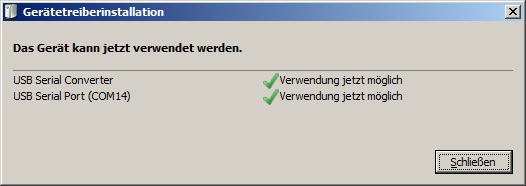
|
Bevor Sie die DPSI TWIN Mini mit dem DPSI TWIN Mini Verbidungskabel an den PC anstecken, sollten Sie im Gerätemanager den COM-Port ermitteln, den die Installationsroutine auf Ihrem System angelegt hat. Lassen Sie hierzu das DPSI TWIN Mini Verbindungskabel angesteckt und öffnen Sie den Geräte-Manger in der Systemsteuerung. Hier sollte nun ganz oben unter dem Punkt "Anschlüsse" der entsprechende COM-Port zu finden sein.
| Windows Gerätemanager |
Im Beispiel wurde der COM-Port COM14 installiert. Da unter Umständen mehrere COM-Ports auf einem System vorhanden sein können, sollten Sie sich den korrekten COM-Port merken, da dieser später in der "TWIN MINI Admin" Software angegeben werden muss.
Anschluss des DPSI TWIN Mini an den PC
Um die DPSI TWIN Mini mit dem PC zu verbinden, muss das DPSI TWIN Mini Verbindungskabel an die serielle PC-Schnittstelle COM des DPSI TWIN Mini sowie an einer USB-Schnittstelle am PC angesteckt werden. Details zu den Anschlüssen der DPSI TWIN Mini finden Sie im Kapitel Anschlüsse.
Info: Das DPSI TWIN Mini Verbindungskabel sollte immer an der USB-Schnittstelle angesteckt werden, an der es während der Installation des USB-Treibers angesteckt war.
Konfiguration mit der TWIN Mini Admin Software
Folgende Modi sind einstellbar:
- Failsafe-Modus (bei Auslieferung voreingestellt)
- Teaching-Modus
Details zu den unterschiedlichen Modi finden Sie im Kapitel Funktionen und Modi.
Um die DPSI TWIN Mini mit der TWIN Mini Admin Software zu konfigurieren, muss die DPSI TWIN Mini mit dem DPSI TWIN Mini Verbindungskabel an den PC angeschlossen sein. Ebenso muss die DPSI TWIN Mini mit einem externen Akku über den Anschluss "Externe Stromversorgung" mit Spannung versorgt werden.
Hinweis: Schließen Sie den externen Akku erst an den Anschluss "Externe Stromversorgung" nachdem Sie die PC-Software gestartet haben.
Gehen Sie zum Programmieren wie folgt vor:
- Starten Sie die PC-Software
- Schließen Sie den externen Akku an den Anschluss "Externe Stromversorgung" an
- Klicken Sie innerhalb von 5 Sekunden auf die Schaltfläche "Verbindung zur DPSI TWIN Mini aufbauen bzw. trennen", siehe Abbildung...
Hinweis: Text.
Technische Daten
| Versorgungsspannung | 4,8V … 8,4V |
| Nenneingangsspannung | 5,2V .... 7,4V |
| Ruhestrom (eingeschaltet) | ca. 15mA gesamt (ohne externe Beschaltung) |
| Max. Dauerstrom über Anschluss opt. Bat. | 25A |
| Max. Dauerstrom über Anschlüsse B1 und B2 | 8A |
| Anzahl der Empfänger | 2 Empfänger mit je 16 Kanälen inkl. Failsafe-Kanal |
| Servoimpulsbreite (korrekte Werte) | 0,8ms ... 2,2ms |
| Servoimpulsbreite (Fehlererkennung) | < 0,8msec oder > 2,2msec oder Impulsabstand < 10msec oder Abstand > 40msec |
| Anzahl der Servos | 16 |
| CE-Prüfung | Gemäß 2004/108/EC |
| Umgebungsbedingungen | -10°C .... +50°C (Betrieb) |
| Zulässiger Temperaturbereich | -25°C .... +85°C (Lagerung) |
| Filterung (EMI) | für 16 Servoausgänge |
| Abmessungen inkl. Anschraub-Laschen | 88mm x 60mm x 28mm (L x B x H) |
| Schraubdurchmesser für Befestigung | 4 x 4,2mm für M4 Schrauben |
| Lochabstand für Befestigung | 77,6mm x 48,2mm |
| Gewicht | 82g |
Abmessungen
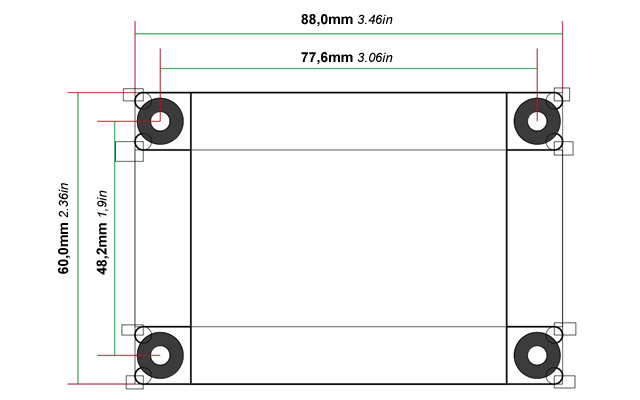
|
Downloads
Aktuelle Downloads
Derzeit sind keine aktuellen Downloads verfügbar.
